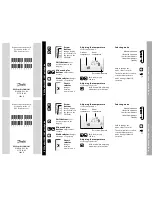
S5-115F Manual
Rules Governing the Use of the S5-115F
10.10.2 Type 9 and Type 10 Digital Output Modules
Type 9 digital output modules have the following characteristics:
•
Safety-related
•
Intermittent output signal
•
They are operated both in subunit A and subunit B (two-channel configuration) and must
have the same module address in both subunits.
•
They are combined with readback inputs (R DIs) which monitor the outputs for discrepancy
times.
•
Type 9 DQs are automatically tested with simulated intermittence during restart. Special
checking after extended shutdown periods is therefore not necessary.
Type 10 digital output modules have the following characteristics:
•
Safety-related
•
Intermittent or non-intermittent output signal
•
They are implemented in subunits A and B in two-channel configuration and must have the
same module address in both subunits.
They are combined with readback inputs (R DIs), which monitor the outputs for discrepancy
times.
•
Simulated intermittence of ”0” or ”1” signals takes place once every test cycle.
Requirements to be met by digital output modules
In the case of safety-related DQ signals, the interval between two edge changes must be greater
than the short discrepancy time for DIs without interrupt capability.
10.10.3 Connecting Actuators to Digital Output Modules (DQs) (Types 9 and 10)
You can choose either of the following methods for connecting actuators to digital output
modules:
•
Direct control, if the module switches the load without an interposing relay
•
Indirect control with readback direct at DQ, load is switched by an interposing relay
•
Indirect control with readback at load cicuit, load is switched by an interposing relay
EWA 4NEB 811 6148-02
10-29
















































